 Search by Keyword
Sign Up Below for our MONTHLY BEATLES TRIVIA QUIZ!
|
“MAGICAL MYSTERY TOUR”
(SMAL 2835)
Released November 27th, 1967
The Beatles had raised the bar to new heights with the release of their June 1967 album masterpiece “Sgt. Pepper’s Lonely Hearts Club Band.” The music, artwork, album packaging, and even the look of the group themselves had changed so dramatically with that release that no one would be surprised by anything else the group might have up their sleeves for the future.
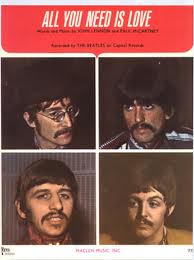 “Sgt. Pepper,” as well as their July single “All You Need Is Love,” dominated the radio airwaves and home turntables throughout the world, most notably in America and Britain. The infatuation with that album continued throughout the year, keeping it in the number one position on the Billboard album chart until November and in the top five for the remainder of the year. “Sgt. Pepper,” as well as their July single “All You Need Is Love,” dominated the radio airwaves and home turntables throughout the world, most notably in America and Britain. The infatuation with that album continued throughout the year, keeping it in the number one position on the Billboard album chart until November and in the top five for the remainder of the year.
Meanwhile, The Beatles were hard at work on a brand new project designed to further "turn on" their world audience, although a major portion of this audience would never experience it until many years later. The project was a new film entitled “Magical Mystery Tour,” which was debuted on British Television on December 26th, 1967. Plans to release it for American audiences were cancelled because of the overall critical slamming it received in the UK. Since American television didn't acquire the rights for broadcast, as far as the US market was concerned, there was no such thing as a “Magical Mystery Tour” movie. Most American fans didn’t know it existed until about a decade later.
What they did know, however, was the music. They knew that very well! With the echoes of “Sgt. Pepper” still ringing through the EMI studios, The Beatles took great pains to record six amazing psychedelic songs as the soundtrack to the film. The production values were still very high as they took their time to perfect these new audio creations.
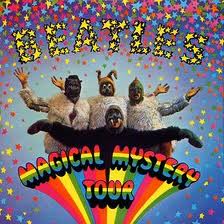 Of course, six songs were not enough to release as a follow-up album to “Sgt. Pepper,” and they were too busy creating the film to throw together more music. Therefore, it was decided that the six songs would be released as a double EP to accompany the film, EPs remaining a popular format in Britain at the time. This, however, was not the case in America, the small handful of Beatles EPs released here not even making it to the Top 40. US audiences just didn’t buy EPs. Of course, six songs were not enough to release as a follow-up album to “Sgt. Pepper,” and they were too busy creating the film to throw together more music. Therefore, it was decided that the six songs would be released as a double EP to accompany the film, EPs remaining a popular format in Britain at the time. This, however, was not the case in America, the small handful of Beatles EPs released here not even making it to the Top 40. US audiences just didn’t buy EPs.
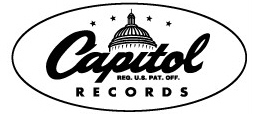 According to the November 25th, 1967 issue of Billboard magazine, Capitol Records made a “decision to issue the six soundtrack recordings from The Beatles’ forthcoming TV fantasy spectacular, ‘Magical Mystery Tour,’ on an album in the US” These six songs would comprise side one, and the five tracks the group released as singles that year would make up side two. This decision was deemed a wise one since, on the coat-tails of the incredible success of “Sgt. Pepper,” American audiences were sure to jump on with both feet. According to the November 25th, 1967 issue of Billboard magazine, Capitol Records made a “decision to issue the six soundtrack recordings from The Beatles’ forthcoming TV fantasy spectacular, ‘Magical Mystery Tour,’ on an album in the US” These six songs would comprise side one, and the five tracks the group released as singles that year would make up side two. This decision was deemed a wise one since, on the coat-tails of the incredible success of “Sgt. Pepper,” American audiences were sure to jump on with both feet.
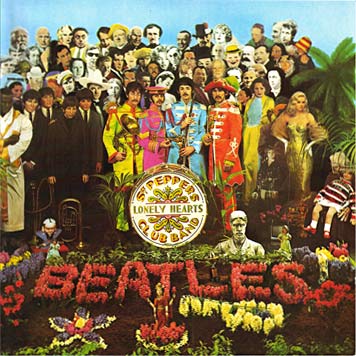 And jump they did. With an elaborately packaged fold-out album cover, complete with a 24-page booklet featuring costumed Beatles in a variety of 'far-out' poses as well as storyboard cartoon comics that tell the story of their "mystery" journey, the album was viewed as an incredibly imaginative follow-up to “Sgt. Pepper” that seemed to take the “summer of love” to yet another level. While the liner notes explained that the music was “from a color television film,” this apparently went unnoticed for most American fans. The music, along with the vivid imagery of the elaborate packaging, was more than enough for what the senses could handle. What better follow-up to “Pepper” could there possibly be? And jump they did. With an elaborately packaged fold-out album cover, complete with a 24-page booklet featuring costumed Beatles in a variety of 'far-out' poses as well as storyboard cartoon comics that tell the story of their "mystery" journey, the album was viewed as an incredibly imaginative follow-up to “Sgt. Pepper” that seemed to take the “summer of love” to yet another level. While the liner notes explained that the music was “from a color television film,” this apparently went unnoticed for most American fans. The music, along with the vivid imagery of the elaborate packaging, was more than enough for what the senses could handle. What better follow-up to “Pepper” could there possibly be?
Origin Of The Album
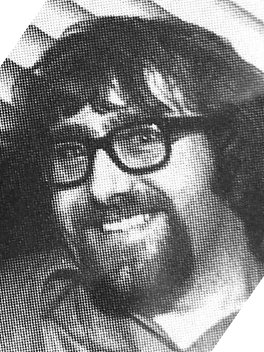 To explain the origin of the album is to actually explain the origin of the film, which was the primary objective of what was to be their next project. “Privately, I’d got a camera and I would go out in the park and make films,” explains Paul McCartney. “We’d show our little home movies to each other, and we’d put crazy soundtracks on them. I used to do a bit of editing at home – I had a little machine and I was getting very into it. So for the next Beatles project, I thought: ‘Let’s go and make a film – what a great thing to do.’ It was all done on whims.” To explain the origin of the album is to actually explain the origin of the film, which was the primary objective of what was to be their next project. “Privately, I’d got a camera and I would go out in the park and make films,” explains Paul McCartney. “We’d show our little home movies to each other, and we’d put crazy soundtracks on them. I used to do a bit of editing at home – I had a little machine and I was getting very into it. So for the next Beatles project, I thought: ‘Let’s go and make a film – what a great thing to do.’ It was all done on whims.”
The idea for the film was solidified during Paul’s trip to America (April 3rd to 12th, 1967) just after recording for the “Sgt. Pepper” album was completed. On the return trip home on April 11th, with roadie Mal Evans at his side, Paul pieced the idea together.
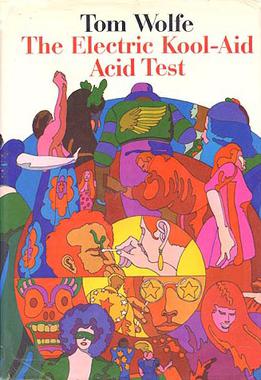 According to Beatles friend Pete Shotton, "’Magical Mystery Tour’ was inspired by the freewheeling adventures of Ken Kesey’s Merry Pranksters, as chronicled in Tom Wolfe’s book ‘The Electric Kool-Aid-Acid Test.’” Author Barry Miles, in the book “Many Years From Now,” elaborates: “In 1964 Kesey and his cohorts had painted a 1939 International Harvester school bus in psychedelic colors and taken it on a transcontinental tour of the USA, dispensing LSD along the way and filming and recording every dramatic encounter, intending to make a movie called ‘The Merry Pranksters Search For A Cool Place.’ The film never materialized but the bus trip became the stuff of legend, eventually being written up by Tom Wolfe in ‘The Electric Kool-Aid Acid Test.’” Pete Shotton continues: “Paul had proposed that The Beatles simply travel around the English countryside with a bus load of fat ladies, dwarfs, and other groovy people, and film whatever happened to happen.” According to Beatles friend Pete Shotton, "’Magical Mystery Tour’ was inspired by the freewheeling adventures of Ken Kesey’s Merry Pranksters, as chronicled in Tom Wolfe’s book ‘The Electric Kool-Aid-Acid Test.’” Author Barry Miles, in the book “Many Years From Now,” elaborates: “In 1964 Kesey and his cohorts had painted a 1939 International Harvester school bus in psychedelic colors and taken it on a transcontinental tour of the USA, dispensing LSD along the way and filming and recording every dramatic encounter, intending to make a movie called ‘The Merry Pranksters Search For A Cool Place.’ The film never materialized but the bus trip became the stuff of legend, eventually being written up by Tom Wolfe in ‘The Electric Kool-Aid Acid Test.’” Pete Shotton continues: “Paul had proposed that The Beatles simply travel around the English countryside with a bus load of fat ladies, dwarfs, and other groovy people, and film whatever happened to happen.”
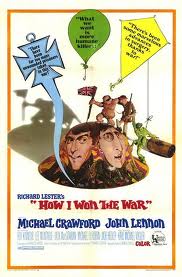 It was also on this return trip home that Paul began writing the title song for “Magical Mystery Tour,” which predated the release of the “Sgt. Pepper” album by nearly two months. However, since Capitol decided to include The Beatles singles released that year on the second side of the album, the first song written for the “Magical Mystery Tour” album dated back to September of 1966 when John Lennon composed “Strawberry Fields Forever” during the filming of the movie “How I Won The War.” The first recording session that was included in the results of the “Magical Mystery Tour” album, therefore, was a session for “Strawberry Fields” on November 28th, 1966, the last session being November 2nd, 1967, this being a final bass guitar overdub for “Hello Goodbye.” So, in retrospect, you could say that it took over eleven months to record the album although, of course, the entire “Sgt. Pepper” album and serveral other tracks were recorded in between. It was also on this return trip home that Paul began writing the title song for “Magical Mystery Tour,” which predated the release of the “Sgt. Pepper” album by nearly two months. However, since Capitol decided to include The Beatles singles released that year on the second side of the album, the first song written for the “Magical Mystery Tour” album dated back to September of 1966 when John Lennon composed “Strawberry Fields Forever” during the filming of the movie “How I Won The War.” The first recording session that was included in the results of the “Magical Mystery Tour” album, therefore, was a session for “Strawberry Fields” on November 28th, 1966, the last session being November 2nd, 1967, this being a final bass guitar overdub for “Hello Goodbye.” So, in retrospect, you could say that it took over eleven months to record the album although, of course, the entire “Sgt. Pepper” album and serveral other tracks were recorded in between.
 Back cover of "Magical Mystery Tour"
|
Album Packaging
With the income generated from “Sgt. Pepper” still pouring in, Capitol didn’t think twice about elaborately packaging the jacket for “Magical Mystery Tour” for the American Beatles fans. The British EP front cover, which showed the group posed in their “I Am The Walrus” costumes below yellow stars spelling out the name “BEATLES,” was cropped and contained with the titles of all the songs above and below. Capitol also reproduced the 24-page booklet that came with the British release, enlarging it to the size of the album cover. As with the British release, the back cover contained a multiple image of the group during the staircase “Your Mother Should Know” sequence of the film. This elaborate packaging stayed in production throughout the years with the exception of the booklet, which was dropped in the late '70s to cut costs.
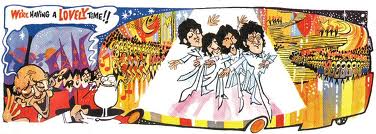
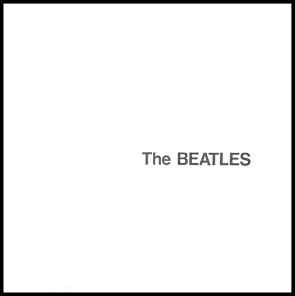 All in all, the artwork was colorful and the packaging much more elaborate than that of the usual '60s pop album. As with their music, The Beatles raised the bar very high when it came to album covers which made the competition think of ways to top what they were offering their fans. As for The Beatles, after the “Pepper” and “Magical Mystery Tour” sleeves, how could they possibly top it? Maybe just a plain white jacket with nothing on it at all! All in all, the artwork was colorful and the packaging much more elaborate than that of the usual '60s pop album. As with their music, The Beatles raised the bar very high when it came to album covers which made the competition think of ways to top what they were offering their fans. As for The Beatles, after the “Pepper” and “Magical Mystery Tour” sleeves, how could they possibly top it? Maybe just a plain white jacket with nothing on it at all!
The idea of converting the film’s soundtrack into a full album was copied throughout the world, even Britain succumbing to the concept in December of 1976. Nine years later, the era of EP’s was dying out in the UK so Parlophone had to recognize that the album format for “Magical Mystery Tour” was a good one after all.
 Picture contained in the 24-page booklet for the "Magical Mystery Tour" album
|
Success Of The Album
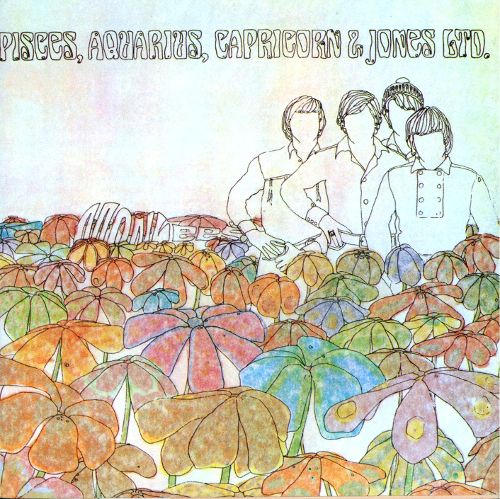 While the film never saw the light of day in the states, the album was an immense success. Being released in late November of 1967, it made the perfect Christmas gift for “Sgt. Pepper” fans, selling more than one-and-a-half million copies in the US before the holiday came. This was reflected in the Billboard album chart where it jumped from #157 in its first week to #4 the week of December 30th, 1967, not quite overreaching the “Sgt. Pepper” album, which was still at #3. By the following week (the January 6th, 1968 issue of Billboard) it took over the #1 spot, the first of eight weeks in a row. In a familiar turn of events, it replaced The Monkees album “Pisces, Aquarius, Capricorn & Jones” at the top spot, just as “Sgt. Pepper” had replaced their “Headquarters” album at #1 back in July. While the film never saw the light of day in the states, the album was an immense success. Being released in late November of 1967, it made the perfect Christmas gift for “Sgt. Pepper” fans, selling more than one-and-a-half million copies in the US before the holiday came. This was reflected in the Billboard album chart where it jumped from #157 in its first week to #4 the week of December 30th, 1967, not quite overreaching the “Sgt. Pepper” album, which was still at #3. By the following week (the January 6th, 1968 issue of Billboard) it took over the #1 spot, the first of eight weeks in a row. In a familiar turn of events, it replaced The Monkees album “Pisces, Aquarius, Capricorn & Jones” at the top spot, just as “Sgt. Pepper” had replaced their “Headquarters” album at #1 back in July.
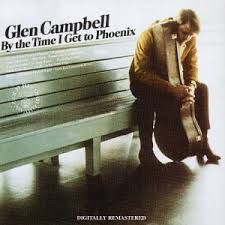 Also of note is the “Magical Mystery Tour” album being nominated for “Album Of The Year” at the 1969 American Grammy Awards. The award went to Glen Campbell’s “By The Time I Get To Phoenix,” but it shows the impact the album had in the US. Also of note is the “Magical Mystery Tour” album being nominated for “Album Of The Year” at the 1969 American Grammy Awards. The award went to Glen Campbell’s “By The Time I Get To Phoenix,” but it shows the impact the album had in the US.
“Magical Mystery Tour” eventually went on to sell over six million copies in America alone, which showed Capitol to have made a very smart move in packaging the film’s music as an album instead of an EP. While their recently renegotiated contract with The Beatles stipulated that future released albums were to contain the same amount of material in the US as in Britain, American fans didn’t feel "ripped off" by the album only containing eleven songs. Most of the Capitol Beatles albums up to this point only featured eleven anyways, and most fans in the states were not aware that this was a makeshift album. Having fewer tracks than “Sgt. Pepper” surely didn’t affect album sales.
Written and compiled by Dave Rybaczewski
CLICK ON THE SONG TITLES BELOW TO READ THE IN-DEPTH HISTORY OF THE SONGS ON "MAGICAL MYSTERY TOUR"
|
IF YOU WOULD LIKE TO MAKE A DONATION TO KEEP THIS WEBSITE UP AND RUNNING, PLEASE CLICK BELOW!
|